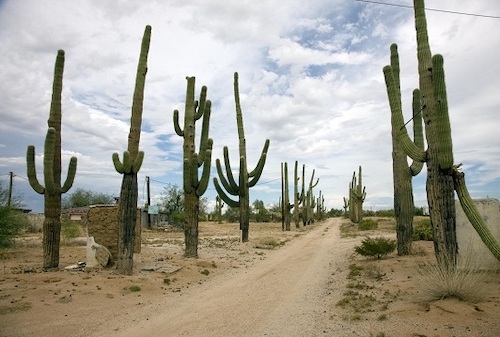The Chronicles Of Grant County
Arizona Street
Hurley
 A view of saguaro cacti in a rural area of Arizona near the Town of Florence. (The photograph was produced by Carol Highsmith and provided courtesy of the Library of Congress, August 25, 2008.)
A view of saguaro cacti in a rural area of Arizona near the Town of Florence. (The photograph was produced by Carol Highsmith and provided courtesy of the Library of Congress, August 25, 2008.)
Arizona Street is a roadway in the Town of Hurley in Grant County. The street was named after Arizona. Several other area communities have roads with this name.
"Arizona, formerly part of the Territory of New Mexico, was organized as a separate territory on February 24, 1863," according to a statement from the Library of Congress. "The United States acquired the region under the terms of the 1848 Treaty of Guadalupe Hidalgo and the 1853 Gadsden Purchase." Both the treaty and the purchase were made with Mexico.
According to the statement from the Library of Congress, "the San Xavier del Bac Mission, completed in 1797, is one of the most famous monuments to the early Spanish presence in Arizona. Jesuit missionary Eusebio Kino laid the foundations for a church on the site around 1700. Spanish missionaries first ventured into Arizona in 1539. With the exception of occasional forays among the Native Americans living in the northern part of the state, the Spanish presence in Arizona was limited to scattered missions, ranches, and forts in the Santa Cruz Valley south of Tucson. By the time the United States acquired Arizona, many remnants of Spanish influence in the state were gone…"
Arizona used to include what became the Las Vegas Metropolitan Area.
A statement from Clark County, Nevada, indicated that the U S Congress passed legislation on May 4, 1866, that transferred part of northwestern Arizona to Nevada – chiefly the lands of the Arizona Territory that were then west of the Colorado River.
"By the 1880s, the Arizona Territory was bustling with fortune seekers hoping to strike it rich," the statement from the Library of Congress noted. "The discovery of gold in 1863 near Prescott, which became the territorial capital in 1864, and the 1877 discoveries of silver at Tombstone, near Tucson, and copper at Bisbee, brought back many of those who had traveled through Arizona in 1848 on their way to the goldfields of California."
Arizona became the forty-eighth state in 1912.
Native Americans have been – and are part – of the framework of life in Arizona.
The Arizona Department of Education reported that 22 Federally-recognized Native American tribes, communities, and nations. Some of the communities are composed of multiple nations. For example, the Salt River Pima-Maricopa Indian Community detailed in a statement that the community "…is comprised of two distinct Native American tribes: the Onk Akimel O'odham (Pima) and the Xalychidom Piipaash (Maricopa). The center of our aboriginal territory is located in what is now called the Phoenix Valley, but our villages and farms previously occupied vast stretches of land along the Gila and Salt Rivers."
The nickname for Arizona is the "Grand Canyon State."
Among the official symbols of Arizona, according to the Office of the Governor of Arizona, are the blossom of the Saguaro Cactus as the state flower, turquoise as the official gemstone of the state, the Palo Verde as the state tree, the Cactus Wren as the state bird, and the Ringtail as the official mammal of the state.
Do you have questions about communities in Grant County?
A street name? A building?
Your questions may be used in a future news column.
Contact Richard McDonough at chroniclesofgrantcounty@mail.com.
If your email does not go through, please contact editor@grantcountybeat.com.
© 2023 Richard McDonough